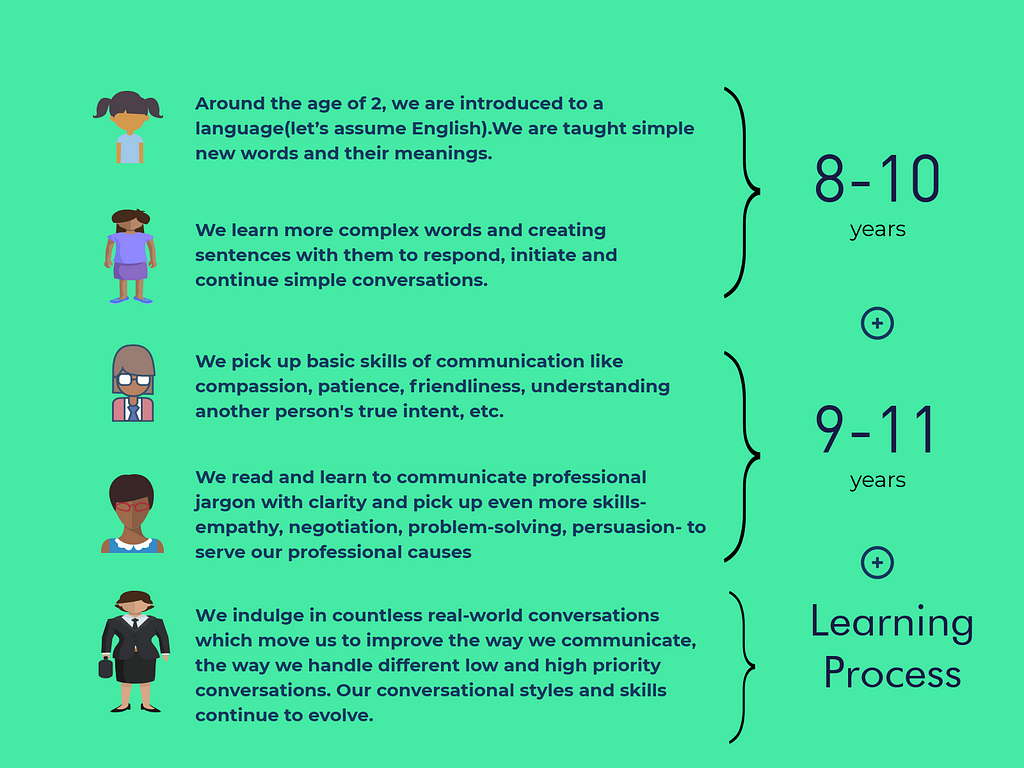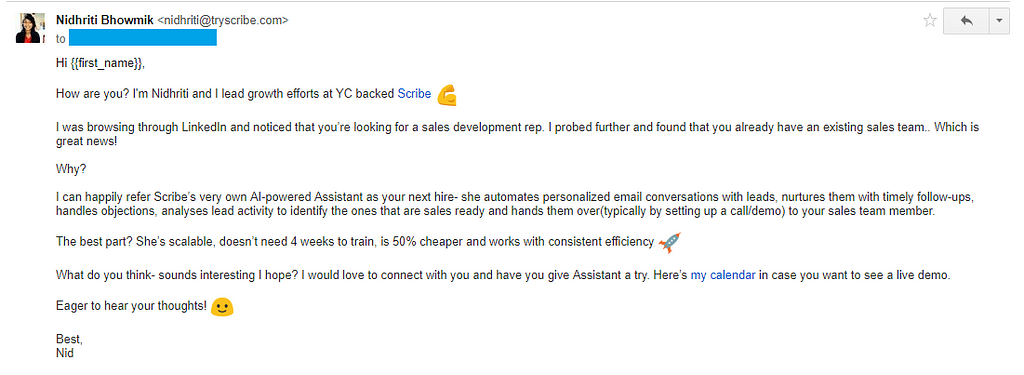Latest news about Bitcoin and all cryptocurrencies. Your daily crypto news habit.
 Source. Illustration by the amazing Eran Mendel.
Source. Illustration by the amazing Eran Mendel.
We’ve heard this debate before: Artificial Intelligence is taking over (notice the ominous tone)!
AI is getting better, smarter, faster and more accurate at automating time-consuming, repetitive tasks. Not just tasks that need extremely high processing powers like data scraping and analysis, intelligence gathering, identifying patterns, etc but also tasks that humans have predominantly owned for decades.
Staunch AI believers have their arguments- It’s not about writing code to serve specific tasks anymore! AI is learning, and AI is learning fast.
//Full disclosure: I just recently joined the amazing team behind Y Combinator backed Scribe, an AI-powered sales conversation tool that lays the groundwork to help sales professionals and leaders focus on selling and building relationships. Their passionate vision and perspective towards AI attracted me at the get go, which is also partially where I got inspiration for this piece.
In this article, I shed light on human learning curves, why AI too deserves one and last but not the least, how Scribe’s slightly different approach towards tackling and automating sales conversations might just save the day!//
The argument continues like this: Artificial intelligence(AI) will become as smart as Human Intelligence(HI). This hypothesis is in fact supported by too many studies and forecasts to count!
From there, it’s easy to imagine a competitive world where AI and HI are at each other’s throats in every imaginable industry and role, and ultimately only one intelligence, naturally AI will rule it all!
Now that’s what dystopian nightmares are made of ☠️😨
Why it’s easy to believe and buy into the dystopian AI > HI future?
👉 Chatbots and assistants, everywhere
The rise and popularity of public-facing, tangible AI-powered conversational identities like speech/chat bots( popularized by the likes of Facebook, Drift, Chatfuel, IBM Watson, etc) and virtual assistants adopted by brands and businesses alike have made AI real and accessible to everyone, everywhere . Not to mention, the buzz around humanoid Sophia’s Saudi citizenship!
👉 AI has officially entered every imaginable industry
From AI-powered CRMs to intelligent healthcare apps, from entertainment platforms(think Netflix and Spotify) to self-driven cars- AI is now officially a significant part of a plethora of platforms. The buzzword has clearly caught on and doesn’t look like it will go anywhere.
Why it’s NOT easy to imagine a dystopian future where AI > HI?
👉 Smartness of AI is still questionable
It’s no secret that Artificial Intelligence is just not as smart as many believe. Like every promising new piece of tech, Artificial intelligence is only at its early stages and will need years of development to actually come close to human intelligence.
If you’ve ever interacted with a bot, you know what I’m talking about!
As much as we’d like, we cannot ask a bot anything and expect a perfect response. “Sorry, I didn’t understand. Can you please repeat that?”- You repeat 3 times and voila! patience and tolerance for conversational bots is forever lost.
When it comes to actually trusting and handing over high-priority tasks to an AI there’s an obvious hesitation.
👉 We humans have our strengths
AI might learn fast but not fast enough to adapt human-dominated skills like empathy, imagination, negotiation, critical thinking, decision making, patience, persuasion, so on and so forth.
When it comes to mastering these ‘human’ skills, artificial intelligence has a long, long way to go.
Is there a middle ground- a world where AI and HI join forces? 🤝
There has to be, right? We as a collective bunch have always found ways to jump on board tech advances- some earlier than others. Be it the industrial revolution, when we ditched our farms and lands to operate machines, the rise of computers which gave rise to new and improved ways to do business or the internet wave with the help of which we created a whole new virtual world filled with countless revenue channels.
When it comes to AI however, I feel like we’re missing the whole point! The way we perceive AI must shift from fear and hesitation to compassion and compatibility. We’ve heard this before and it’s stands true more so now- we must collectively think of how AI can make our lives so much simpler, our jobs easier and tasks efficient.
Which brings me to the ability of AI assistants to hold conversations, at scale.
Speaking of AI-powered conversations 💬
Similar to people skills, the ability to hold engaging conversations has been the domain of humans since forever.
If anyone knows how to talk, it’s us! 🤐🤐
But if we traced back to the beginning and asked ourselves: How did all of us actually excel at making conversation?
How did we teach our brains to naturally deduce when we need to persuade/negotiate/acknowledge/be patient, etc?
A simple breakdown of how we, humans learnt to converse:
 Conversational Skills: The Human Learning Curve
Conversational Skills: The Human Learning Curve
Our parents and teachers taught us for years. Yet, we’re still on our own learning curves!
Similarly, AI assistants needs to be taught and trained and we are literally the only guardians they’ll get!
Now, this presents its’ own pros and cons. Pros being AI’s superior processing power, fast speeds and abundant data storage which simply put, implies that they’re way faster learners than we’ve ever been.
The cons however presents it’s own bottlenecks. For starters, knowledge is limitless and conversational boundaries are well boundless. So, to even set out to teach an AI entity how to master all possible conversations is an extremely hard challenge due to obvious restrictions like lack of a data set huge enough to cover all possible conversations!
Hence the smart thing to do was, and still is, to pick a particular industry and a use case and build conversational identities to serve specific and constrained purposes within that use case. Few of the popular bots and conversational identities that serve extremely constrained use cases
Few of the popular bots and conversational identities that serve extremely constrained use cases
It’s important to understand that to build a promising conversational AI model that truly understands and responds to a common language (say English), there are two high-level steps involved:
- Gather historical data and build a predictive model on top of it — that’s where the brilliant minds of AI devs come in! 💡
- Feed this model new data so it can learn from it and make future decisions — that’s where we come in! 💪
With great power, comes great responsibility!
All conversational assistants need both- historical and new data. Without historical data, you’d get a weak foundation which in most cases won’t understand intent or sentiment. Without new data, your AI model would lack confidence + context and thus fail to make conversation.
Speaking from the context of sales, this new data would be your use cases, sales scripts and canned responses for the most popular objections you receive.
For instance, what do you say to a lead who says — “This is not a good time. Reach out to me in October.”
or
“I’m curious. Tell me more.”
or
“We have a very lean budget. What is your typical cost like?”
These are some of the basic but most popular objections one tends to get in sales and surely as a sales professional you would know how to respond to them. So why not pass on that knowledge to your own assistant?After all AI conversations is all about NLP finding a way to identify and match patterns in text (your data) and then dice and slice that text to produce more patterns of text (read: sentences that make sense).
Tackling sales conversations: A new approach 🦄
The first time I met CEO at Scribe, Rutika Muchhala, I remember her saying, “We are trying to do something many before us have but we’re doing it in a way no one ever has!”
My immediate reaction: And..what way would that be?
She went on to explain and the rest is history.
I’m going to try and take a crack at that explanation 🤓
Here it goes:
If there’s one thing that torments every sales professional in today’s day and age it’s the hours spent on following up and nurturing leads plus the number of different scenarios that arise subsequently — did not reach the decision maker hence start all over again, lead is out-of-office hence needs to be contacted later, nurture with or without a given time, so on and so forth.
Then there are more promising leads who come back with questions (read: objections) around the company itself, pricing, competitors, etc —there’s a lot of time and effort that sales professional are spending today on each and every lead before they can even bag a sales call/demo.
In fact, sales professionals are spending less than 36% of their time actually selling!
If one were to scale their current sales and revenue, there would literally be no other way than to shell out a lot of cash on hiring new folks and tools.
Unless of course, there was a way to automate all of the typical email conversations that precede a scheduled sales call? Would that increase efficiencies? How much time would a sales professional save and thus use on more revenue-generating tasks if they could control, monitor and sometimes help an assistant that takes care of their leads for them up until they’re turned into sales ready leads?
This assistant would have to be pretty darn good!
And as you might have guessed, that’s exactly what the tech team at Scribe set out to do(The team have by far been one of the most buzzing work forces I’ve come across!) 🚀
They found a smart way to analyse, categorize and tag every possible sales conversation (releasing tech summary next week!) into a wide range of clearly defined sales buckets with one main goal: automate all of the conversations that lead to a sales call so sales professionals can focus solely on closing and building relationships.
The end result: Assistant from Scribe, an AI-powered conversation tool that—
🔥 Brings conversation automation to email
How? At Scribe, one can write a copy of the email he/shewants to send out and let Assistant personalize and schedule the email for their entire lead list(similar to email sequencing tools) based on their lead status and respective use case.
🔥Loves to get trained
How? Similar to how a junior rep would handle lead objections by referring to say sales scripts, canned responses, a senior rep even, Assistant handles objections by referring to its knowledge base and senior rep a.k.a you.
For starters, one can add objections and their responses to Assistant’s KB as when they like.
The best part: when Scribe gets new objections(not already added in the KB), she immediately sends an alert on Slack to the sales professional/team who trained her.
Simply put, I as the sales professional wouldn’t have to bother about a lead unless they needed my immediate attention/ showed real interest/ booked a call. The more I responded to the fresh objections Scribe received on my behalf, the more robust and encompassing my objection knowledge base would be and naturally Scribe could then handle more and more of my end-to-end conversations over time on my behalf.
🔥 Uses that training to respond to lead objections
How? Whenever Assistant receives a response/objection from a lead it has been trained to handle, it will immediately create a personalized email to be sent to the lead.
In the scenario of new untrained objections coming in, Assistant pulls the response it receives from your sales rep on Slack and immediately creates the email and sends it to your lead.
🔥 Streamlines good leads from the bad ones and schedules calls/meetings with the ones who’re sales-ready
How? Scribe analyses lead behavior and activity to identify ‘warm’ and ‘hot’ leads, thus streamlining them from the bad ones.
From the get-go, Scribe’s primary intention is to always get that call/demo with sales-ready leads so she can successfully hand over the lead to a sales professional who can convert and close.
All this talk, naturally I had to give it a try myself.
Eating our own dog food
👉So I set up this email to be sent out to a batch of 100 highly targeted leads —
 Scribe personalized this email I wrote for my 100 recipients
Scribe personalized this email I wrote for my 100 recipients
👉And set up a follow-up in case they didn’t reply —
And as Rutika showed me earlier, I started seeing these on my Slack channel dedicated to Scribe —
👉 Lead responses and objections which Scribe sent to me on Slack along with suggested replies
 All I had to do was review and approve!
All I had to do was review and approve!
👉 Objections that needed me to intervene because I didn’t train Scribe to handle them
 I didn’t train Scribe for all possible objections, hence this^
I didn’t train Scribe for all possible objections, hence this^
👉And then came the best part: I started seeing a lot of these —
You can imagine my excitement!
Where I would have easily spend 3–4 hours replying to all of my leads, with Scribe I ended up spending a mere 30 minutes spread over a 5-day week.
Bottom Line: Help AI, Help Us!
Scribe restored my faith in a future where AI and humans work hand-in-hand to make each other efficient. It was never about one-sided gains!
I like many others imagine a world where AI serves a rather convenient purpose- the same purpose all great advances in tech have before. The purpose of making our lives more efficient, hassle-free and thus creating space for even more advancements.
So, the sooner we jump on board the AI wagon, the sooner we set ourselves up to stay ahead of the curve 🏄🏄
//A clap here and there, goes a long way: If you liked the read/think Scribe has potential, please 👏 👏 to help this article reach more people.
Happy to start a conversation around AI/automation/sales/everything in between, so please don’t shy away from reaching out!//
The Bittersweet Symphony b/w Artificial and Human Intelligence was originally published in Hacker Noon on Medium, where people are continuing the conversation by highlighting and responding to this story.
Disclaimer
The views and opinions expressed in this article are solely those of the authors and do not reflect the views of Bitcoin Insider. Every investment and trading move involves risk - this is especially true for cryptocurrencies given their volatility. We strongly advise our readers to conduct their own research when making a decision.




